Read the blog
The 3 Best Books For Tarot Beginners
You’re welcome to comment on the video if you wanna share some of YOUR fave books for tarot newbies, as well. 🙂
In somewhat related news…
After being closed for quite a while, my mentoring services are finally available again. If you feel called to some one-on-one guidance for developing your own tarot practice, mentoring is a great option. Or maybe you are looking to level up in business and could use a grounded chat with a more seasoned entrepreneur. Whatever you’re looking for in a mentorship, you + I will customize the focus areas of our sessions to fit your unique situation. Details are here.
Begin or deepen your tarot studies with
Foundational Tarot, my free video course!
Join the email list for instant access.

Tarot of the Holy Spectrum Walkthrough
I talk about this in the video, but this is an indie deck I came across on Instagram a while back, and by the time I got around to thinking about purchasing it, the first edition was already sold out. Luckily there’s now a second edition, which is what I have here. You’d think as an indie deck creator myself this would be a lesson I’d learned by now: when you see an indie deck you vibe with, buy it immediately, if you can! Because you never know when they may be gone.
Tarot of the Holy Spectrum was created by Chase Voorhees. Chase is married to Lindsay Mack, whom I became acquainted with about a year ago when she reached out to Annie & I with some wonderful praise about our deck, the Spacious Tarot. Through our brief email exchanges, Lindsay and I discovered some very cool synchronicities in how we view tarot. It’s an honor knowing Lindsay has and admires the Spacious Tarot, and now I have and admire Chase’s deck. He includes a note sharing his gratitude to Lindsay, as her thoughts have greatly informed his process.
The deck is inspired by the Rider-Waite-Smith, but brings some fresh energy and new takes on the cards as well. It doesn’t come with a guidebook, giving you lots of room to feel into your own interpretations of the imagery. Of course, you should really just watch the video to hear more and see every card! But here’s a little peek + some additional things I noticed after filming the video.
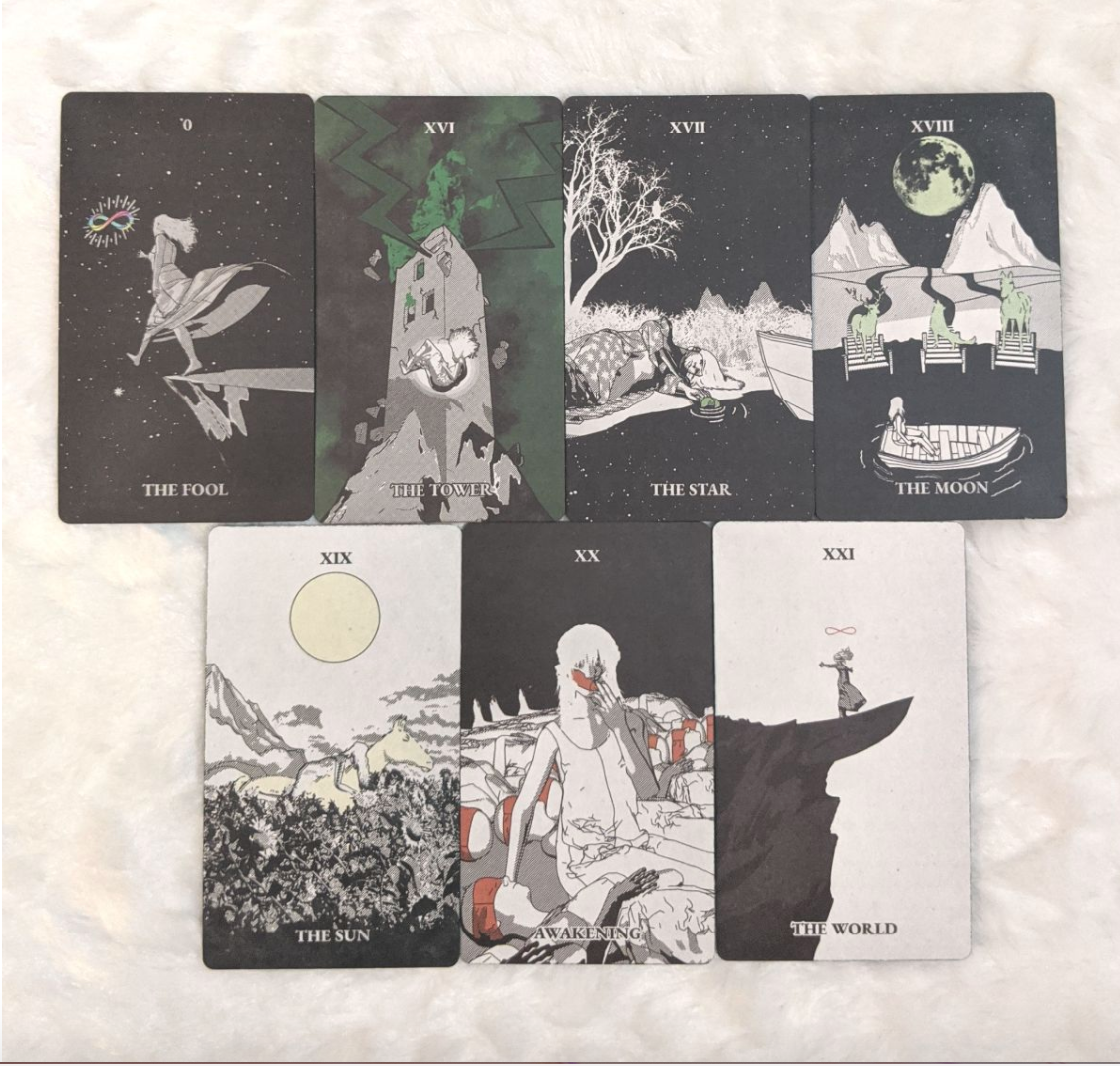
It was only after filming the video I realized many of the major arcana cards seem to feature the same character. In particular, I see a story unfolding from The Tower to Awakening (the retitled version of Judgement).
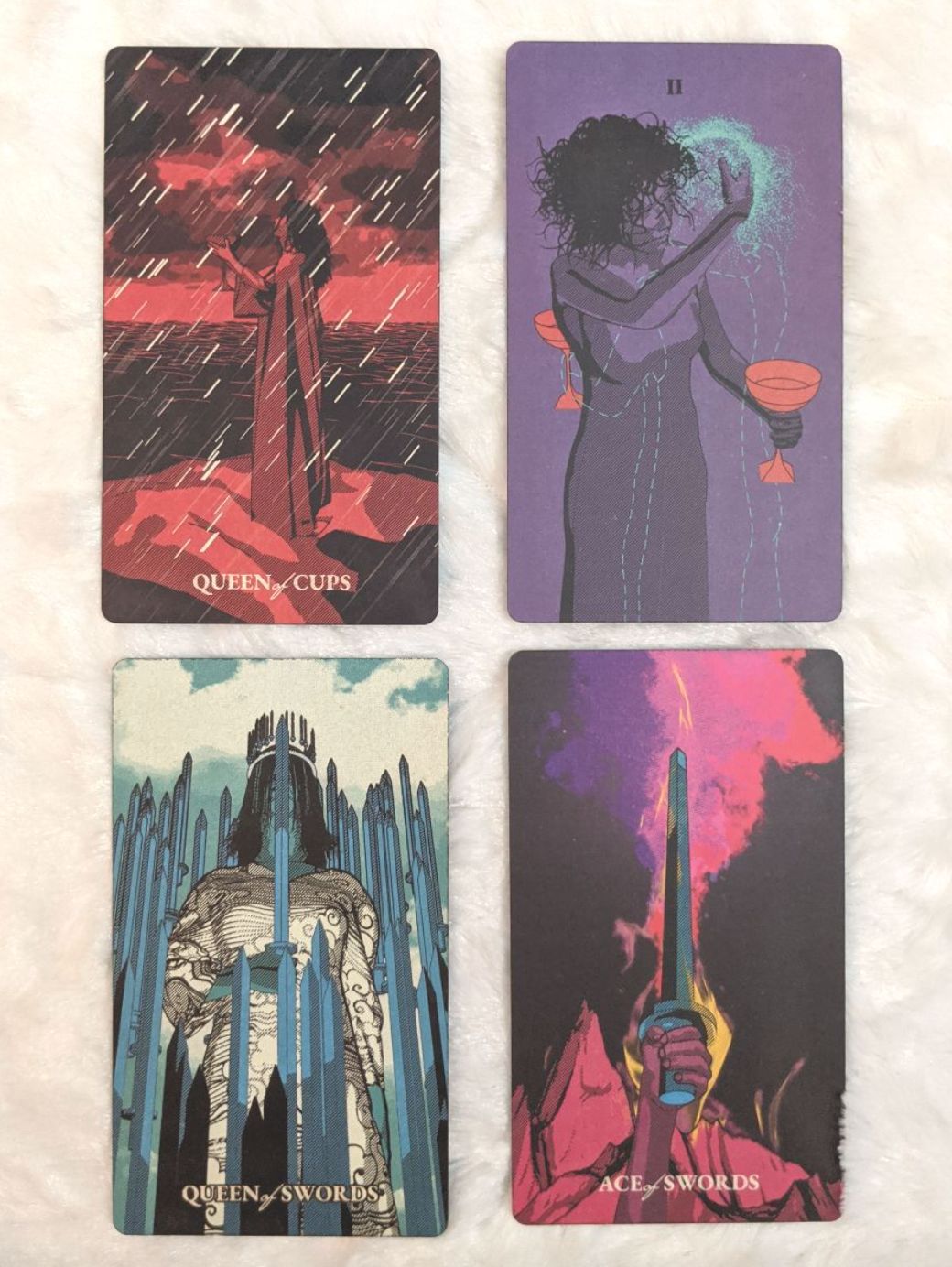
Out of my own collection, this deck reminds me most of my beloved Hayworth Tarot. They both have a surreal style that I really love. I talk about this in the video too: they’re two of the only decks with humans I’ve been able to connect with lately. Apparently I connect best with human figures if they are somewhat abstract.
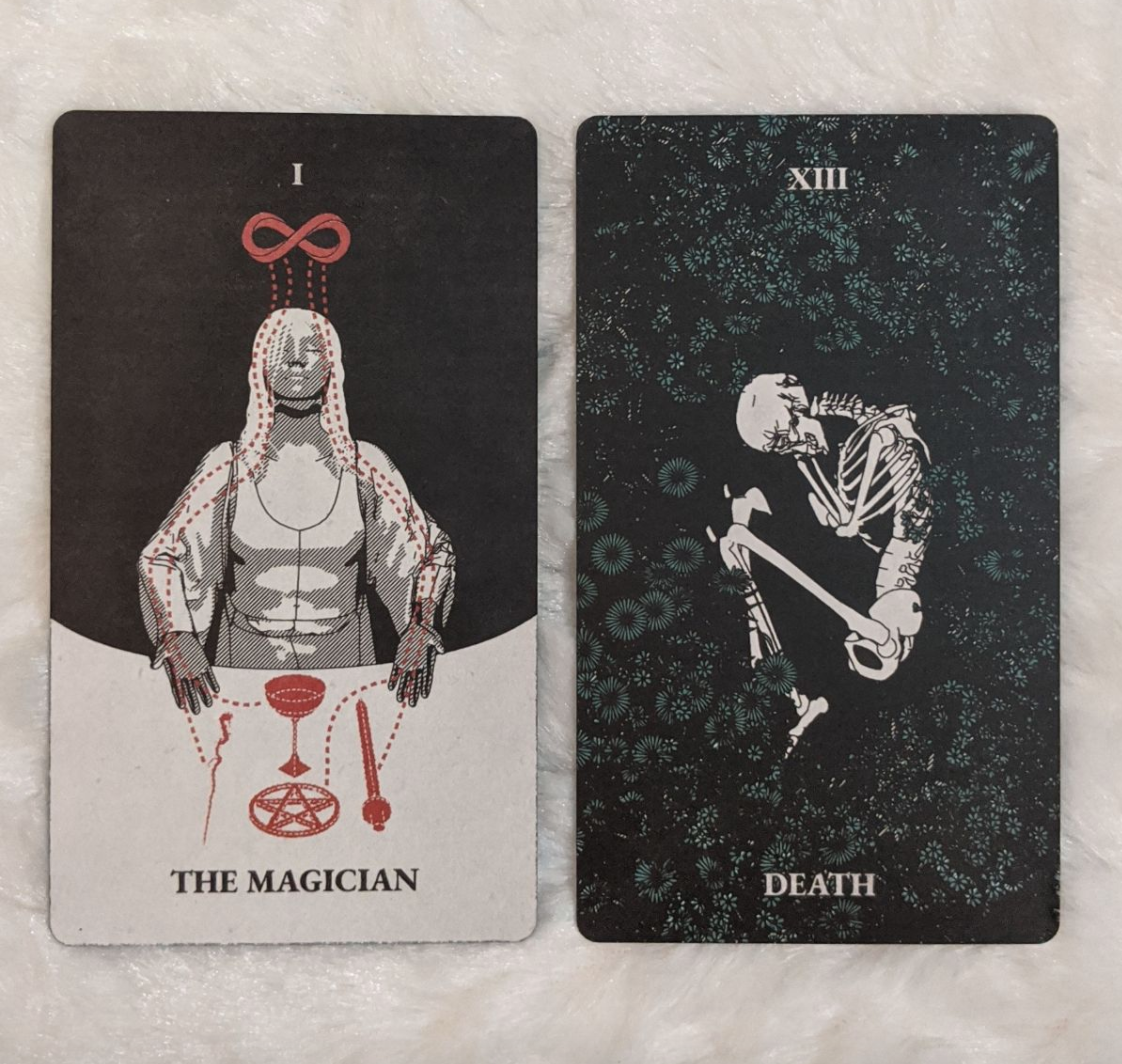
I love this Death card, and that’s saying something, because there’s actually not many Death cards I really love! We have the skeleton, obviously, but what I really like is how it is curled up in the fetal position. And the plant life around it almost looks like a sort of womb. A connection to the fact that Death and rebirth and intricately linked.
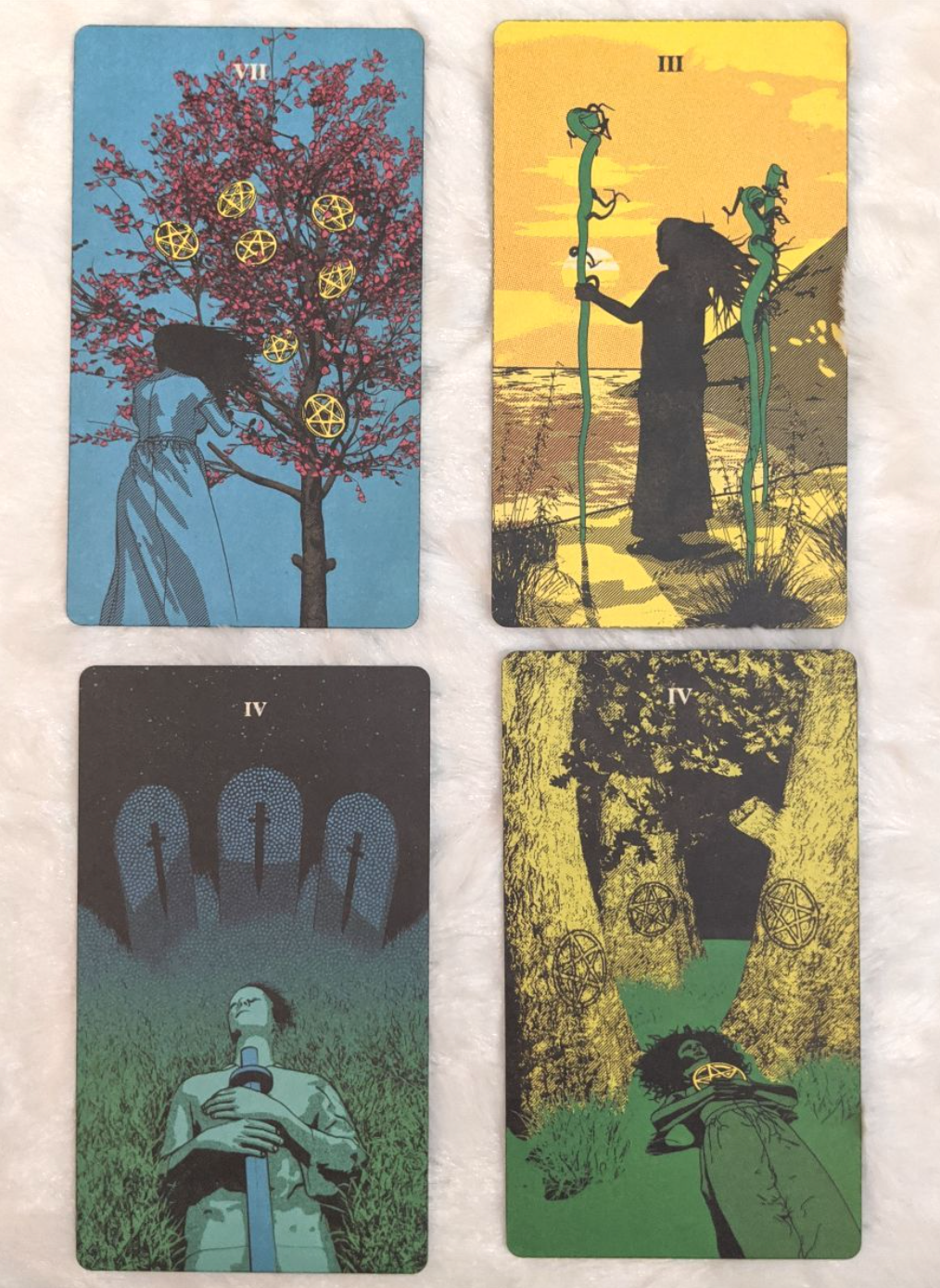
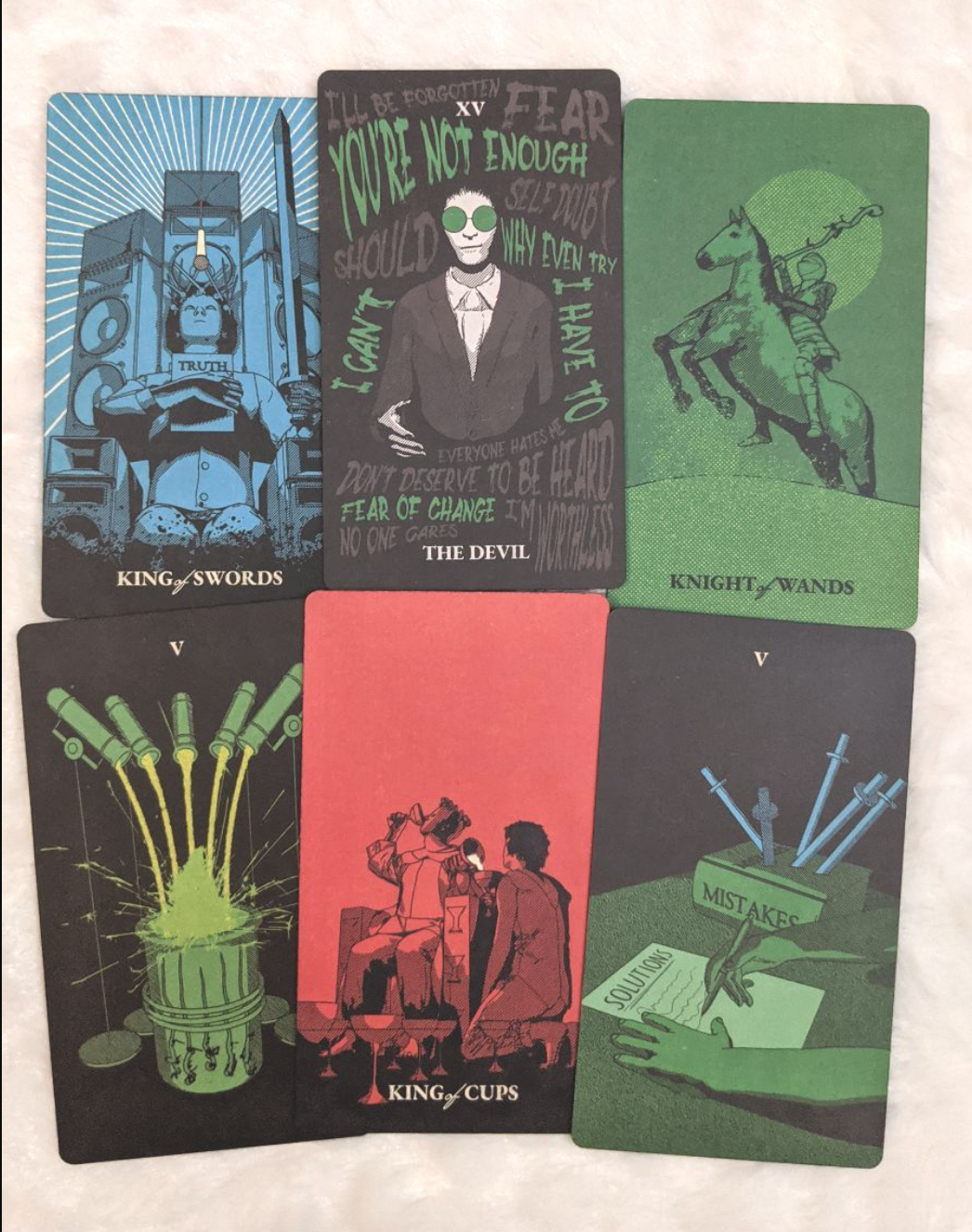
I’m sure I’ll get to the point where I can work with ALL the cards. Some will just take a little more exploration and curiosity.
So there you have it! Some initial reflections on a deck I’m sure I’ll be turning to a lot in the future, Tarot of the Holy Spectrum. You can purchase the deck here and watch my full walkthrough video here.
Sign up for email updates and get
Foundational Tarot, a free video course!
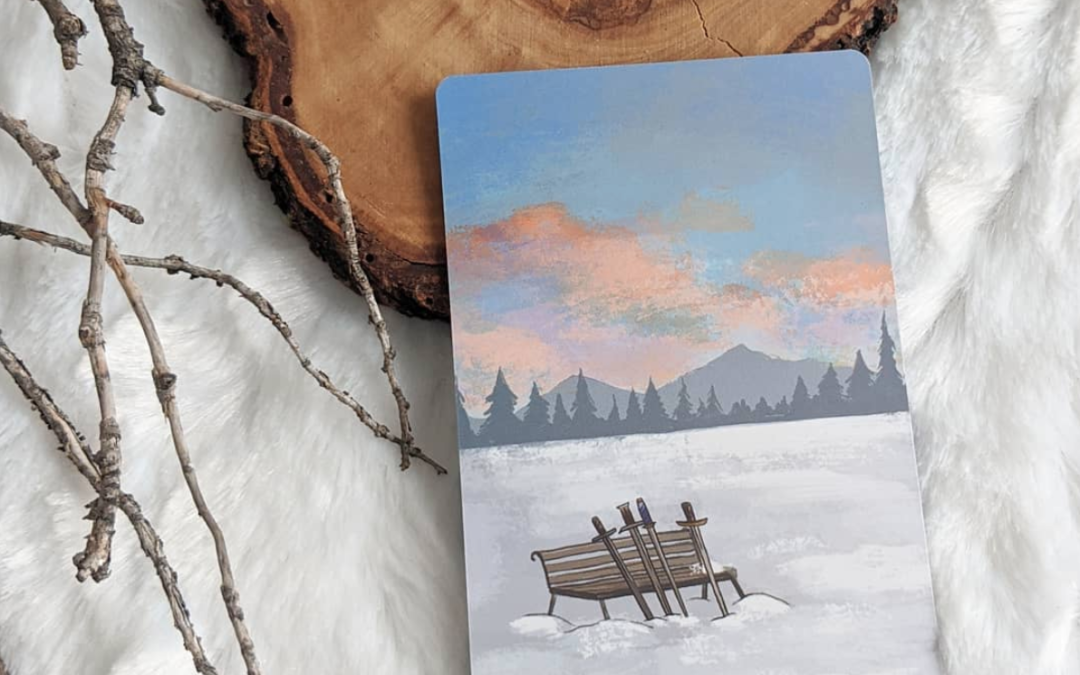
Four of Swordsing
That’s what’s been happening for me with Four of Swordsing lately.
I guess it started when I was writing Dreams & Themes for 2021 and the Four of Swords was one of the cards that came up for January’s collective reading.
Not long after that, I came across the Nap Ministry on Instagram – they offer reflections around rest as resistance to white supremacy and capitalism.
And just yesterday, I was listening to an episode of On Being featuring Katherine May, author of a book called Wintering, about holding space for the fallow seasons of life, during both literal and metaphoric winters.

Just this morning someone DM’d me the above photo saying it reminded them of The Spacious Tarot. When I clicked over to see more from the photographer, @mikkolagersted, below was the most recent photo on their feed…

Here where I live, in the land currently known as Utah, we’ve had drizzling snow flurries for a few days now. So in many ways, Four of Swordsy messages are presenting themselves to me. Synchronicities abound.
My keywords for this card are reprieval and contemplation. In the guidebook for the Spacious Tarot I wrote that this card is “a disengagement from the go, go, go mentality of the dominant culture.” Swords are associated with the mental realm, so naturally they have to do with learning. But they also have to do with unlearning.
The concept of ‘unlearning’ is something I’ve seen coming up in wider and wider circles lately, and I love welcoming this notion into a mainstream conversation. So many things I’ve learned personally – and so many things we’ve learned collectively – are harmful, superficial, destructive, outdated and tired.
Part of the lesson of the Four of Swords is unlearning the story that being constantly “productive” is indicative of your worth. It’s particularly challenging when we do exist within broader systems that still push this narrative. But it gives me hope to see so many people questioning this concept and moving into new narratives. New narratives, fuck yeah!
There’s an interesting nuance in how I’ve been thinking about the Four of Swords lately. It’s a four, and fours have broader themes of stability. But in any deck (and of course, particularly in the Spacious Tarot) this card has always felt expansive to me. This card doesn’t symbolize a fixed mental state – which would be a perfectly reasonable interpretation when combining the suit and element. No, the Four of Swords symbolizes a centered mental state.
So a question to ask yourself: what does it mean to you to be centered? What centers you? Are you truly valuing those things? Are the things that once served you in this capacity still effective? How can you carve out more space for yourself and others to become centered? And how can you engage with these questions not from a place of rushing to find an answer, not from a place of pressuring yourself, but from a place of gentle openness?
That idea of gentle openness and expansiveness is essential. I love the vast, snowy landscape on the Spacious Tarot version of this card (and the photographs shared above too). There’s room here for your mind to wander. Meander. Drift, as snow drifts. All of this drifting is not aimless. On the contrary, it is necessary for the kind of deep processing and centering we are called to personally and collectively.
In a conversation with a client recently, we talked about the fact that snow is quiet. Snow actually absorbs sound waves, so when there’s a blanket of snow on the ground, the noise level literally drops. I love this as a metaphor for dialing down the static and attuning more acutely to subtle messages within and around you. Listening is a integral part of Four of Swordsing.
And one more loose connection to draw for now. I think there’s some tie ins here to the last post I wrote about the Hierophant and belief systems. I wrote “no matter how rigid belief systems or societal norms seem, there’s always the potential for them to disintegrate and take new shapes.” I think some of the Four of Swords explorations above support those reflections on the Hierophant.
Wishing you spaciousness + centeredness for your own Four of Swordsing,
Sign up for email updates and get
Foundational Tarot, a free video course!
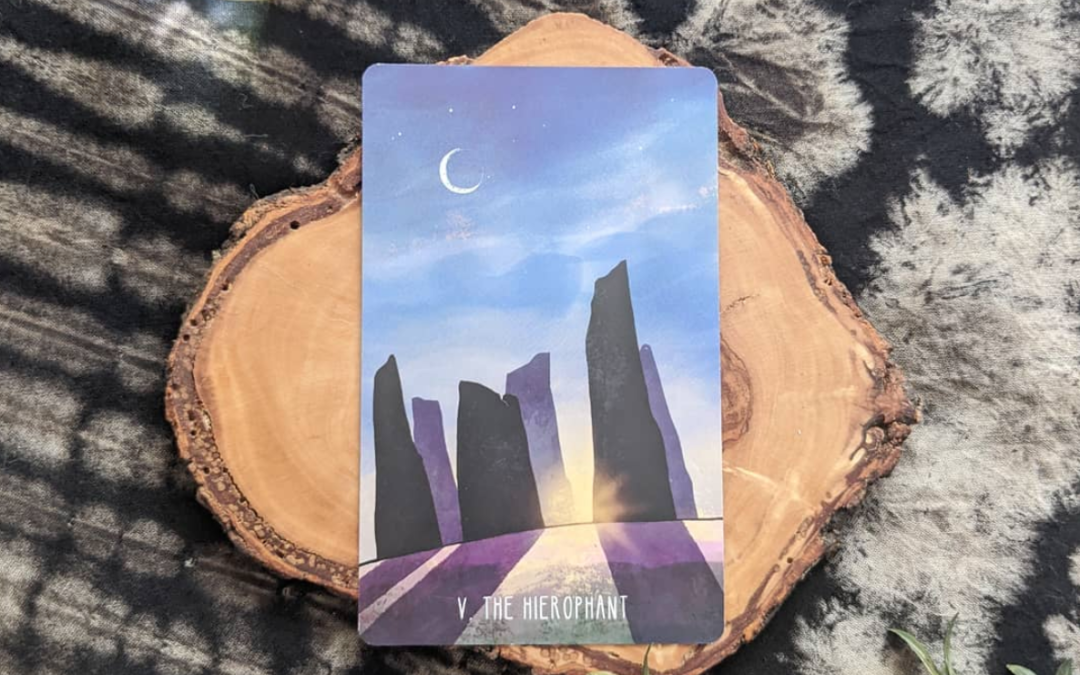
Bridges & beliefs w/the Hierophant
It’s a pretty good vibe. That’s something I’ve always been into – creating a good vibe. But during 2020 it became a lifeline, basically. Gotta have time to integrate and reconnect so that you can show up fully for…well…the whole spectrum of reality.
Anywhooo…
We’re gonna talk a little about the Hierophant today. I don’t have a particular plan here, just a meander that I hope will be at all interesting.
A while back I wrote a post on 2020 being an Emperor year and now we’re in 2021 which is a Hierophant year, in theory. As I mentioned in the last post, this isn’t a concept I have particularly strong beliefs on or convictions in, it’s just something interesting to think about. I think we could find connections to any card in the deck during any year but this type of thing gives some focus.
That’s actually a great segue into talking about the Hierophant since this card is all about belief systems! 😀
Imagine my “HMMMM!” reaction when I sat down on January 1 for my very first daily draw of 2021 and pulled The Hierophant from the Hayworth Tarot (a deck I fell madly in love with during 2020).
Here’s what I wrote:
This Hierophant from the Hayworth Tarot seems like a bogey man with his surreal face and hands up like “boo.” A lot of people dislike the Hierophant as its imagery often evokes traditional religious iconography. But to me, the core of this card is about belief systems and societal structures.
Yes those things can be scary and stifling and controlling, but ultimately they are human constructs. No matter how rigid belief systems or societal norms seem, there’s always the potential for them to disintegrate and take new shapes.
We’ve already been seeing the process of old, rigid traditions starting to unravel. Some people will choose to double down and do anything to reinstate the fading bogeyman, but he’s fading anyhow.
Hopefully during 2021 our belief systems can become even more fluid and inquisitive. Less about doubling down on old answers and more open. Less about dogma and hierarchy and more about creating space for everyone to find their own path.
Even though I was referring to the imagery in the Hayworth Tarot there, a few people commented and told me the imagery in the Spacious Tarot (first pic in this message) has helped them really connect to the Hierophant. One person said “I love that you say it’s open and everyone finding their own path. This is EXACTLY how I read The Hierophant in the Spacious Tarot. It’s solid, but there’s space for every individual structure. Everyone gets their time in the sun. The shadows cast change as the season/sun changes and moves.”
Can I just say one of the most amazing things about creating your own deck is hearing other people’s insights on the imagery??!?! I love it.
In older decks this card was known as the Pope. Arthur Edward Waite changed the name, noting “he has been usually called the Pope, which is a particular application of the more general office that he symbolizes.” So the card became the Hierophant, a word connected to Eleusinian Mystery rituals of ancient Greece.
I suppose there may be a tie in here to the imagery we chose for the Spacious Tarot. I can only imagine the Eleusian Mysteries were evocative to Waite and his fancy secret society because they are…well…mysteries. We know some about what happened in these rituals, but there’s a lot of room for projecting your own imagination here (partly because participants in them were sworn to secrecy punishable by death).
Stone circles appeared in a number of places around the world and due to the effort it would have taken to create them, we can assume they were important, even sacred places. But we do not know exactly how they were used. Again, we have some information, but much is left to be filled in by imagination and intuition. It’s a paradigm shift from the Pope imagery which might imply being told what to believe, and into the opportunity to develop your own unique beliefs.
Any way you look at it, I think it helps not to get too hung up on just the religious/spiritual aspects of the Hierophant. The way I learned tarot (shout out to Joan Bunning) this card is about belief systems in general, it can relate to education, and also has an overarching theme of group identity.
All of this obviously can operate in very shadowy ways. People can get so caught up in any belief system that they commit extreme acts or refuse to even consider things that challenge their worldview. People can get so fixated on their group identity that they shun or even harm those who don’t conform to it. One of my hopes for 2021, as it relates to the Hierophant, is that as a collective we maybe start doing a better job navigating the shadow aspects of the Hierophant, because they continue to cause us a lot of problem and it would be great if we could get a little more adept here. There’s more to the Hierophant than the shadow for sure, but we’re unwise to ignore the shadow here or anywhere.
Hoo boy. There’s really SO MUCH MORE to say about all of this, so perhaps I’ll write some more about the Hierophant as the year progresses. I think for now, the last thing I want to touch on is the connection between the Hierophant and the Emperor. These cards do have some overlapping themes. In 78 Degrees of Wisdom Rachel Pollack says:
“…we can see the Hierophant as a companion to the Emperor. The word ‘pope’ means ‘father’, and like the Roman Emperor the Pope is seen as a wise father guiding his children. Together, they share responsibility for humanity, the one providing physical needs, the other guiding spirutual growth.”
And then there’s this great insight from Alejandro Jodorowsky:
“The Pope bears the number 5. This number has evolved from a complete foundation in reality (the number 4) to acquire an objective beyond its position. The Pope takes one more step than the Emperor, he establishes a bridge that makes it possible to proceed towards this ideal.”
So that’s another powerful, Hierophant-inspired hope for 2021: may this be a year of finding bridges and beliefs that move us closer to an ideal.
Sign up for email updates and get
Foundational Tarot, a free video course!
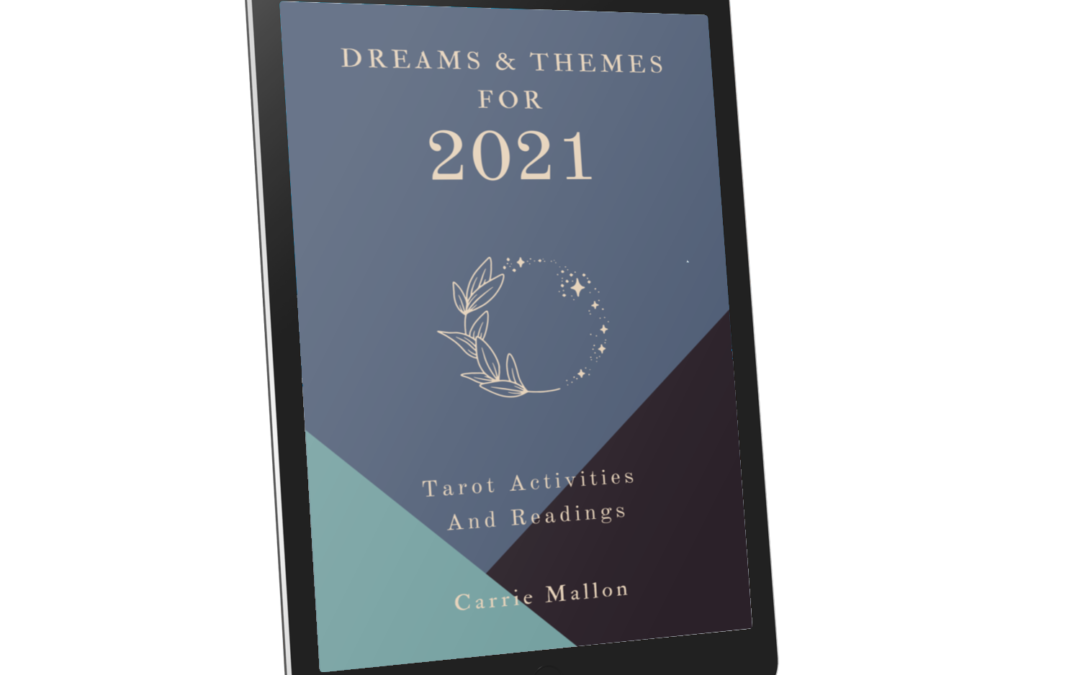
Dreams and Themes for 2021
Dreams & Themes for 2021: Tarot Activities & Readings
This interactive ebook guides you through tarot-inspired exercises for integrating 2020 and setting your tone for 2021. Perfect for tarot readers of any level! Also contains collective tarot readings, written by Carrie, for each month of 2021.
$18 USD, instant download.
~offer expired~
This 67 page PDF ebook is a simple but powerful ritual for processing what the past year has meant to you, as well as envisioning what may be on the horizon during 2021. All you need is any tarot deck and an open heart.
Dreams & Themes is composed of three sections:
Part 1: Personal Dreams & Themes
This is the heart of the workbook. A few examples of tarot activities you’ll find here:
~ A tarot spread for identifying your blessings of 2020
~ New Year intention setting using the four tarot aces
~ Finding and learning from your ‘inner teacher’ card in 2021
~ ‘Cheers to the New Year’ themed tarot spread
~ plus more!
You can type your responses to the activities directly into the PDF, or print the ebook out and write in it by hand, if you prefer.
Part 2: Collective Dreams & Themes
In this section, I offer tarot readings for the collective for each month of 2021, helping us feel into broader universal energies. I’ve also included journal prompts to take you deeper into the personal resonance of each reading. A sneak peek at the themes explored in the monthly readings:
~ February: Rosy Views
~ March: The Work of Integrity
~ April: Ending Unknown
~ May: Deflect Assumptions
~ June: Depths of Desires
~July: Honoring Your Pace
~ August: Tending the Flames
~ September: Offering and Receiving
~ October: Owning Your Affections
~ November: Shifting Availability
~ December: Essence in Motion
Part 3: Monthly Reflections
Finally, this last section gives open-ended space to reflect on your personal readings, or the collective tarot readings, record your dreams, or use however you’d like.
Available as an instant download for only $18. Once you’ve made your secure purchase via PayPal, you’ll be redirected to a download link. May Dreams & Themes for 2021 inspire, uplift and serve you well!
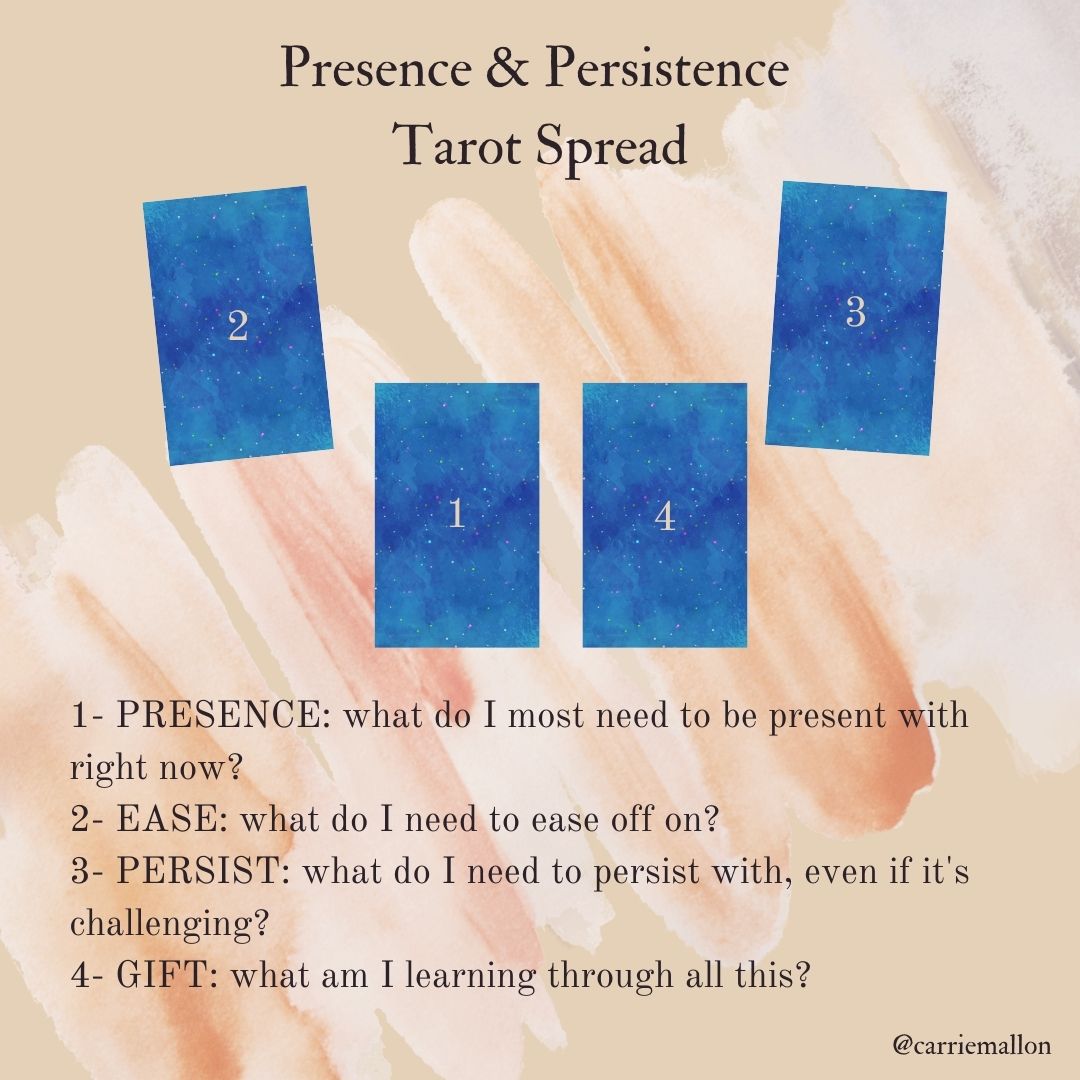
Presence & Persistence tarot spread
some way or another,
here we are in the final stretch of 2020.
You belong to this time and space. It may not be perfect or easy or what you imagined. There may be some discomfort and frustration, but hopefully there’s some good and magic and wonder, too. Whatever’s coming up for you now, it’s all okay. You’re here, you made it. You’re doing awesome and I’m proud of you.
Today I’ve created a tarot spread called ‘Presence & Persistence’ for you. Lots of people (myself included tbh) have done some shit talking about 2020. And, well, some of it was warranted. It’s been a strange and challenging year for most of us. But I always try to balance out the shit talking with expanded perspectives and gratitude and presence. Because when you look up and zoom out, there’s lessons and beauty to see.
So instead of just saying ‘screw this year, bring on 2021’ I’m looking for ways I can be present and persist during this last stretch of the year. Instead of what I sometimes want to do, which is dissociate and hide away.
Even as this year dissolves and a new year begins, I’m still me and you’re still you. The calendar is merely a construct. Even as it changes, we’re still here, dealing with our individual stuff and our collective stuff. So I wanted this spread to be something you can use now, with the specific intention of navigating the last stretch of 2020. But it’s also something you could turn to anytime you feel the need.
I’ll share a graphic below, and then I’m going to pull some cards for a sample spread for the collective, so stick around to read that message if you’d like. Then try the spread for yourself!
I will be using the Centennial Smith-Waite tarot to offer messages for the collective using this spread. I’ve drawn the following cards:
1- Presence: Temperance
2- Ease: Three of Pentacles
3- Persist: Nine of Wands
4- Gift: King of Cups
To me, Temperance feels like a perfect card to see when asking what we most need to be present with right now. In Temperance, our mantra might be “this is where I am. This is what I’m doing.” In the background of the card a windy path leading towards a glowing mountain peak. What’s that, what’s there? The angel is in no rush to find out. They are not trying to project themselves into the future. They are here, they are now, and that is enough. How can you, too, take this approach? Instead of being lured in by visions of what might lay around the corner down that windy path and into 2021, how can you more thoroughly merge with THIS energy, THIS moment? As I said – quite a perfect card to see when we’re asking about presence.
The way the angel moves the liquid back and forth between the cups just so exemplifies a partnership with what is. The cups seem to be an extension of the angel’s very self. As such, we must remember that our energy is extended into everything we’re doing right now. This can be a very magical thing. Should you choose to bake bread, your energy is extended into the bread and nourishes those who eat it. Should you choose to text a friend, your energy ripples out. The influence may be subtle, but you have influence. Use that influence with care, be conscious of how your energy emanates.
The Three of Pentacles might ask us to ease off on expectations around other people’s contributions. A tough thing to do, as certain situations (like, say, global pandemics) remind us that other people’s actions truly do affect the whole, for better or for worse. This is less about letting others get away with recklessness and more about returning our attention to our OWN contributions. Where could YOU be doing better right now? How can YOU set a better example? What influence do YOU have, and how can you use it with greater skill?
In a similar vein to Temperance, the Nine of Wands is another card that feels quite on the nose for the spread position. We ask about persisting, and get a card showing someone who looks like they’ve BEEN THROUGH IT, they’re tired, they’re wounded. Yet here they are, persisting. Holding down the fort, shoulders tense, wall of wands ready and on guard. Once again, I can’t help but seeing this card through a pandemic-tinted lens, because really, aren’t we all tired of this shit? Don’t we all feel like we’ve been social distancing and wearing masks and trying to maintain our sanity and our livelihood and our health for SO LONG?
The fact is that we have, and it’s okay to feel weary and on edge, whether it’s about the pandemic or anything else. The Nine of Pentacles brings to mind that somewhat irritating but often true statement “you can do hard things.” That said, I think there’s a need here to remind yourself that you’re not alone. Get a friend on zoom or on the phone and reconnect and remember that you’re not the only feeling drained and basically OVER IT. The way the cards are positioned within the spread, the person on this card seems alone but his gaze is directed towards the other cards. A reminder to get outside of your bubble – not physically, but energetically.
I think this card connects back to the message of Temperance as well, because you need to honor the difficulty of this time but you also need to tap into pockets of healing and reprieve and replenishment. A few weeks ago I wrote a post about activating your parasympathetic nervous system and that’s kind of paralleled in this spread, with the Nine of Wands showing a stress response and Temperance inviting in a rest + replenish response. Both are real. Your struggles are valid, but there are ways to find healing and restoration in their midst.
And then we have the King of Cups helping us identify gifts, what we’re learning. Visually, there’s some connection between this card and Temperance: similar background color, both hold cups, both have water. Like Temperance, the King of Cups reminds you of your capacity for ‘riding the waves,’ being present with the ups and the downs, the times when you feel sea sick and the times when you feel in awe of the vast ocean of life.
We’re learning to be present with the full spectrum of experience without getting totally thrown off our throne. I would go as far as to say we’re learning to “love what is,” as cliche as that might sound. The King of Cups truly brings us back in a perfect circle to something I said before I even pulled the cards at the beginning of this message: whatever’s coming up for you now, it’s all okay.
So that’s that! It was illuminating for me, and I hope the collective messages gave you something to sit with. And if you’d like, please do try the spread for yourself! I hope it brings you something useful and meaningful.
Sign up for email updates and get
Foundational Tarot, a free video course!
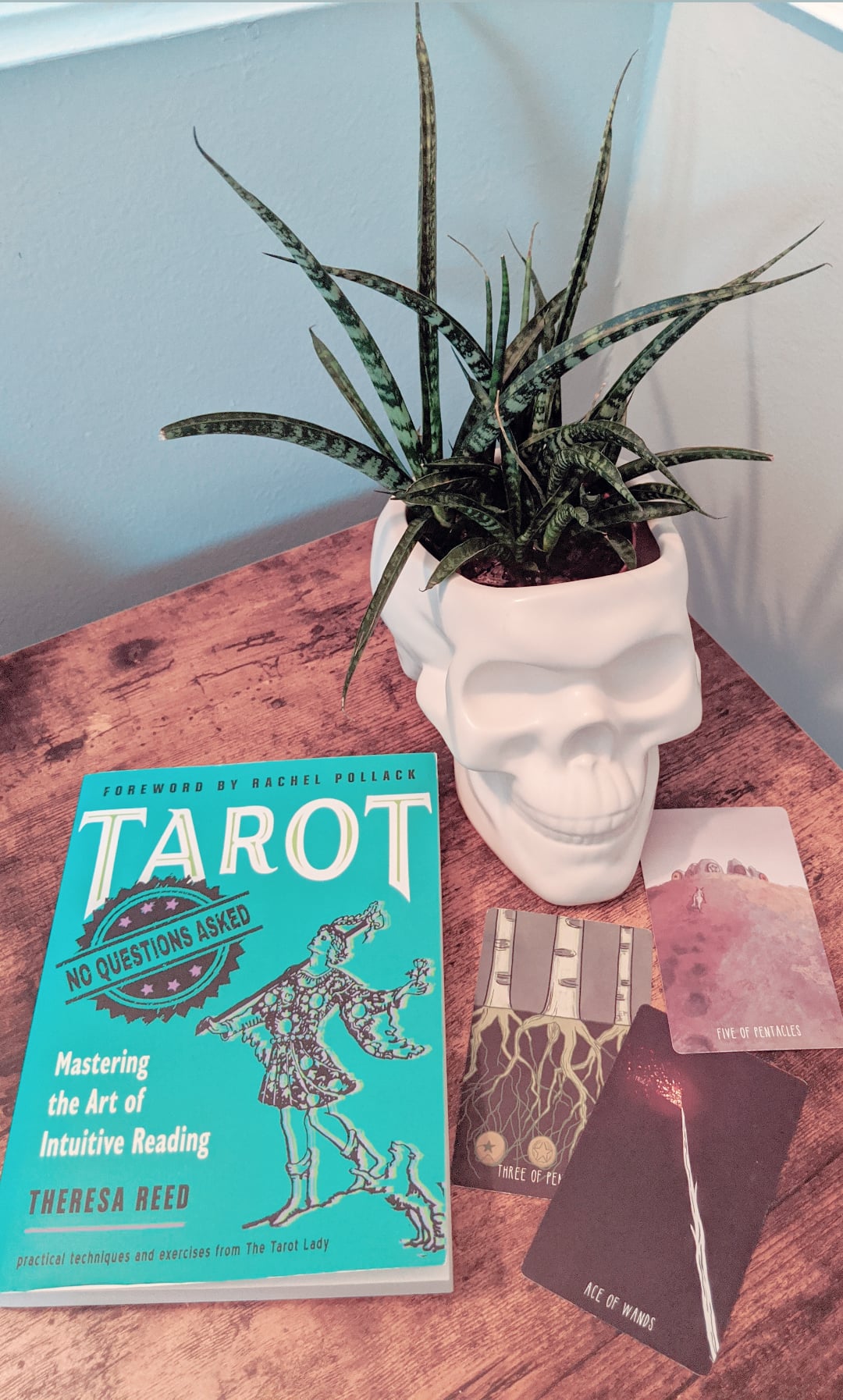
Tarot: No Questions Asked
I just finished reading this new book, so we’re gonna talk about it today! I was sent the book by the publisher. However, all thoughts are my genuine opinions. Plus, I would have bought this book anyway, which is why I said YES.
Sidenote: they say don’t judge a book by a cover, but can we do that for just a second? Because I love this cover. Very Instagrammable, is it not?
Theresa Reed’s writing has a conversational tone. The introduction was written by the legendary Rachel Pollack and describes the book as “unpretentious.” I think the straightforward tone of the book would make for a welcoming experience if you’re new to tarot and feel put off by convoluted philosophies. It’s not that this book doesn’t go deep, it’s just that it does so with humor and levity. For example, this passage talking about the Empress: “This card can also represent sensuality. Time to indluge in some pleasurable activities? Uh-huh. Boom chika wow wow!”
The book is made up of three parts: Tarot Basics, Intuition Basics, and Road Testing Your Skills. It would be suitable for a total beginner as Tarot Basics section covers the standard stuff you’d find in most beginner texts: tarot history and myths, components of the deck and so on. This is all pretty brief and the bulk of the first section is a card-by-card meanings glossary for all 78 cards.
The meanings articulated here are pretty on par with what you’d think of as ‘traditional’ meanings for the cards, delivered with ‘Tarot Lady’ style. They make up a good chunk of the book (over half). Theresa teaches using the Rider-Waite-Smith and does reference some of the specific symbols in this deck. That said, even if you use another deck you could still get something out of this. I found the interpretations broad enough that I think they’d give you something to think about no matter what deck you’re working with. I actually did most of the exercises with The Spacious Tarot, pictured above.
To me, the most interesting part of the interpretations was the information on reversed meanings. Theresa has a really different way of reading reversals than what I use in my own practice. As Theresa herself writes, “if you want to see tarot people argue, ask their opinion about reversals.” Made me lol because ain’t it the truth? She goes on to write that using reversals or not is up to you, which I completely agree with. In Theresa’s style of teaching, reversals can signal “blocked energy or something stalled…..(or) the opposite meaning of the card.”
As I said, very different from my personal style, but I think as a reader it’s good to keep your mind open and at least consider other ways of doing things! That’s actually something Theresa herself mentions in the book’s conclusion: “you mustn’t get too stuck in your ways or develop what I call ‘bad tarot habits’ of only seeing the cards from one perspective, including mine.”
My favorite part of the interpretations – and really, my favorite part of the entire book – was the “tarotcises” offered for each card. I will admit I haven’t actually done all of them, but I have done a few and always found them enriching. I’m sure that the tarotcises are the part of the book I’ll find myself revisiting most often in the future.
As an example, here’s the tarotscise for the Emperor: “the Emperor is such a severe dude. For this Tarotcise, try to find something soft about him. Study the card carefully. Where might you find tenderness in the Emperor?”
The second section of the book, Intuition Basics, is a well rounded primer in different types of intuitive abilities and exercises for enhancing intuition. When you use the word ‘intuition’ around tarot readers, we all have different ideas of what this means. Theresa’s style of intuitive reading is not that out of line with what some people might call predictive or dare I say “psychic” reading.
It’s another way in which this book asked me to come out of my set in stone ways, as someone who is constantly telling my clients “I’m not psychic and I don’t read predictively.” It’s not that I have an issue with predictive reading, it’s just not something I think of myself as particularly skilled at. That said, some people ARE skilled in this, and if that’s you, there’s definitely a market for it.
Theresa does explain that she doesn’t believe readers can “see it all” or that tarot can predict everything. Essentially, if you choose to read predictively, Theresa says “we can see where actions may be leading, but there is always the possibility you will misinterpret information or the querent may decide to make a change.” Throughout the book, she shares anecdotes about readings she’s conducted over the years. I quite enjoyed reading these – maybe her next book will just be Memoirs of a Tarot Reader with all kinds of stories! I would totally read that.
Part three, Roadtesting Your Skills, covers everything from creating the right environment for a reading, to shuffling and cleansing your deck. There’s a section on spreads, including sample interpretations. This is another section I think would be particularly useful for beginners (but also readers of any level!) because it’s nice to see how an experienced reader ties the cards together and forms an interpretation. This section is rounded out with plenty more tarotcises and even has an informative little section on going pro as a reader, should that be something you choose to pursue.
Overall, this book would be great for a beginner looking for a breezy, approachable primer. I think it’s worth a purchase for the tarotcises alone. As I already mentioned, even as a more ‘advanced’ reader I really like the tarotcises and I’m sure I’ll refer to them again. Consider ordering this one from a local book shop, they really need the support! Or you can get it on Amazon.
In other news…I’m finally open for tarot readings again! As my business evolves, I’ve been spending more time lately shipping out my own deck and have been less available for client work. I’m in a rhythm – for now – where shipping is manageable and I look forward to connecting with you if you feel inspired to book a session.
Going forward, I will continue this approach of monitoring my time and energy to determine when it is wise to open for client sessions, and when I need to take further breaks. My priority is always showing up with the right energy and focus to offer really valuable sessions. I appreciate your patience and understanding as this continues to shift and cycle.
All the details are here.
Take care,
Sign up for email updates and get
Foundational Tarot, a free video course!

Activating your parasympathetic nervous system
There’s been a few synchronicities around this for me lately. Up until this week, the parasympathetic nervous system was something I was vaguely aware of but hadn’t given much thought. This week, I was suddenly seeing it mentioned in multiple places: first in a book I’m reading, Tarot for Transformation by Andy Matzner (highly recommended!), then on one of my favorite podcasts, To The Best of Our Knowledge.
In case you are unfamiliar with this, here’s a very brief explanation via Psychology Today:
“The autonomic nervous system—sometimes called the involuntary nervous system—regulates many bodily systems without our conscious direction, such as the circulatory and respiratory systems. Two of its three branches are the sympathetic nervous system and the parasympathetic nervous system.
When the sympathetic nervous system is aroused, it puts us on high alert, sometimes called the “fight-or-flight” response. The sympathetic nervous system is necessary for our survival because it enables us to respond quickly when there’s a threat. By contrast, when the parasympathetic nervous system is aroused, it produces a feeling of relaxation and calm in the mind and the body.”
The article goes on to point out that many of us are living in constant fight-or-flight mode. This has already been true for a while, throw in a global pandemic and a contentious election cycle in America, plus all the other atrocities happening across the world, and it feels like we’re on collective hyperdrive now. As an aside, if you’re in the US, please vote. I have chosen to vote for the candidate whom, if elected, might actually lower our collective anxiety instead of constantly fanning the flames.
That said, having your sympathetic nervous system overly activated leads to exhaustion, burn-out and anxiety. It prevents us from claiming our full, authentic power. It’s very difficult – sometimes even impossible – to make aligned choices and do meaningful creative things when you are at the mercy of your sympathetic nervous system.
I understood this phenomenon through direct experience even before I had the language to talk about different branches of the nervous system. Back in the Key Finding days (remember I had a podcast once?) I talked about “soothing your frazzled nerves.” I didn’t realize it, but I was talking about activating the parasympathetic nervous system.
Another synchronicity: when the Five of Wands comes up, I often think about ‘frazzled nerves’ or an over-activated sympathetic nervous system. Today I drew the Five of Wands with Temperance. This card combination felt eerily on point as Temperance can be about balance, and arousing the parasympathetic nervous system is described in the same Psychology Today article linked above as ‘restoring balance.’
So how can you calm your nervous system? There are many ideas out there, and you know yourself best. Try a few things and be open to find what works for you. If you already know what works for you but you’ve drifted from those things, return to them. The things I’ll describe from here are just a few that been nurturing for me lately.
Exploring ways to activate the parasympathetic nervous system is fascinating to me because it’s one of those places where psychology and spirituality meet. As one example, there is a long held belief in the power of breath in various spiritual traditions. The research confirms this: deep, mindful breathing is one of the simplest and most effective ways to calm your nervous system.
To be frank, I sometimes get annoyed when I’m told to focus on my breath. But the fact is, if you actually do it instead of just writing this off as a cliché….it does help. Harvard researcher Emma Seppala has worked with veterans experiencing trauma who have seen incredible results using breathing exercises. Seppala says:
“Sounds simplistic, but breathing is probably the most powerful thing you can use to access your parasympathetic nervous system. When you breathe in, your heart rate accelerates and your blood pressure goes up. When you breathe out, it decelerates — your blood pressure goes down. So the simplest thing you can do is start to lengthen your exhales. Taking a few minutes at your desk, closing your eyes and breathing out twice as long as you breathe in is going to calm your heart rate immediately, lower your blood pressure.”
Andy Matzner, who is a licensed clinical social worker and psychotherapist, gives in-depth information about the spiritual and scientific power of the breath in his new book. This book is really an all around treasure trove, but one thing in particular I learned is the importance of breathing in through your nose. Matzner writes:
“The tiny hairs in your nose are called cilia and they, along with a mucous membrane, act as a lint trap, preventing an excess of external particles from getting any further into your body. Cilia also warm and humidify incoming air, which is beneficial for your delicate respiratory tissue.
In addition, breathing in through the nose allows us to breath more deeply, which stimulates the lower lung to send greater amounts of oxygen throughout the body. This type of deep breathing also activates the abundance of parasympathetic nerve receptors that are found in that section of the lung.”
*Cue ‘The More You Know’ music here*
Tea is also a tried-and-true way to calm the nervous system. There’s a reason various cultures have tea traditions: not only the tea itself, but the entire ritual of tea has calming effects. Make choosing your blend a sensory experience by getting whole leaf if possible. Smell it and touch it before brewing. Watch the steam rising from your cup.
Andy Matzner points out that green tea has high rates of an amino acid known for its relaxing properties. Herbal teas are also great options – my personal favorites are peppermint and lemon balm. As an added bonus, tea pairs notoriously well with tarot.
Next up, an example of how intuitive it is to find practices to calm your nervous system. For the past year or so, I have been allllll about epsom salt baths. This isn’t because I read some cutting edge research telling me to take baths, it’s just something I felt naturally drawn to do. Once I did look into it, I found there is actually some evidence supporting this. According to the Cleveland Clinic, epsom salt baths can help soothe physical pain and ease the mind. I like to pair my baths with a soothing music playlist and my new galaxy light projector for possibly the most relaxing vibes ever (video here).
One more thing I wanted to mention today, which sort of circles us back around to where we started: imagery is another potent way to activate your parasympathetic nervous system. Here again we have a connection between the scientific and the spiritual, as the power of visualization has long been revered by spiritual practitioners.
I may be slightly biased, but I must say the Spacious Tarot is wonderful for visualizations and active imagination work. Especially in the major arcana, we designed most of the cards to feel immersive, as though you could move right in. Try going through the deck face-up and choosing an image that calms you. Gaze at the card, while connecting with your breath, and picture yourself immersed in the imagery. The Star is one of my favorite cards for this practice, it makes me feel awe and reverence and as though I am held and safe.
I could go on and on, because there are so many other exercises and modalities out there that might work for you. But I will leave it here for now, and simply encourage you to seek what works for you. Activating the parasympathetic nervous system really matters not just on a personal level, but on a collective level.
A culture of calm lets us act instead of react. Make conscious choices instead of living on auto-pilot. Be led by our desires instead of dragged by our fears. It is a reclamation of your natural state of being. It is a return to something your soul knows is right. It is a part of healing yourself, and in turn healing the whole.
Begin or deepen your tarot studies with
Foundational Tarot, my free video course!
Join the email list for instant access.
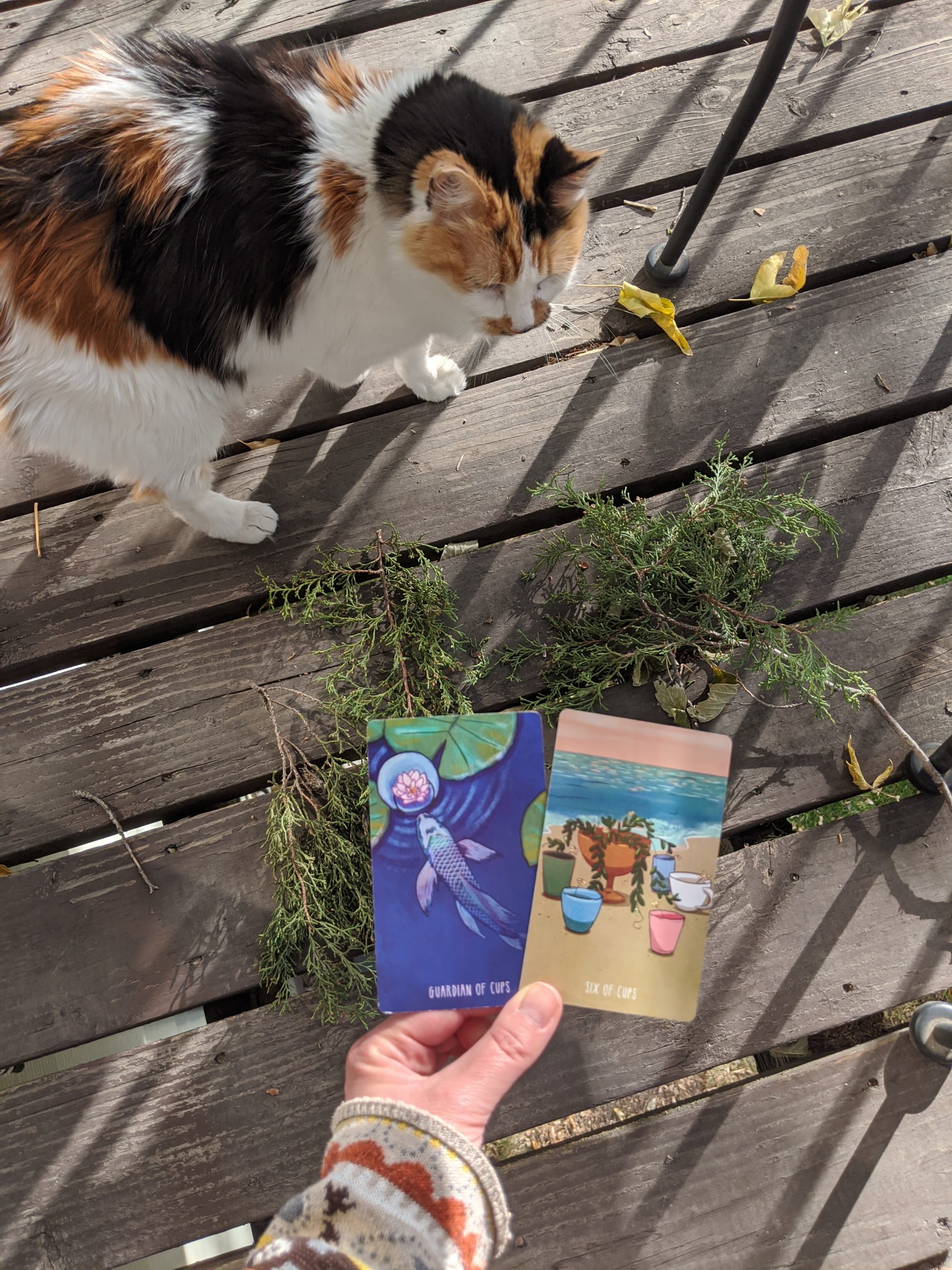
I will cry
I’m sitting on my back porch so that when I’m not squinting at the computer screen, I can gaze out at the big trees in my neighborhood. It’s that kind of classic fall day where the leaves are golden and red and the sun gleams off them in just the right way to amplify their magic. There’s enough of a chill breeze you know it’s fall, but enough sun that you’re still radiant.
Lulu’s here too – she’s an inside cat but she occasionally gets to venture to the balcony. Right now she’s meowing at a cheeky squirrel who is doing parkour around the yard.
A few months ago I wrote a post using a method described by Mary K Greer as writing from your heart with tarot, and I’m going to do that again today, using the Spacious Tarot.
I shuffled and pulled the Guardian (Queen) of Cups.
This morning I was remembering a random meme I came across a while back where this person had a shirt that said “Don’t fuck with me” and in the next frame you could see the back of the shirt said “I WILL cry.” I personally relate very much and I need this shirt.
A few days ago, I went for a walk with one of my best friends who has recently gone through a great loss and we talked about the value of crying. Emotions are physiological sensations, and crying is part of the body processing them.
A few hours ago on my Instagram feed I saw a post by @sitwithwhit with a list of things you might say to someone in distress instead of telling them not to cry.
Around lunch time today, I told my husband that I feel like crying today. Why? I don’t know, why NOT?! It’s not about any one particular thing, sometimes I just feel like crying.
And as a sort of jarring contrast, yesterday on a walk I passed an apartment with a huge flag in their window that said “Trump 2020: FUCK YOUR FEELINGS.” Which ties into that whole ‘snowflakes’ thing in which being sensitive is equated with being weak or irrational or incapable.
Last week I talked about the Elder of Cups. And now I draw the Guardian of Cups. It all seems connected.
The core thing is this: the Guardian of Cups shows you that you can have firm boundaries (the cup inside of the flower) while still honoring your emotions. You can have a “don’t fuck with me” vibe while tears are streaming down your face. You can be sensitive and be a bad-ass as the same time.
Telling someone not to cry or saying “fuck your feelings” is not edgy or helpful. It’s passé.
The Guardian of Cups is emblematic of a new wave. This wave subverts outdated misunderstandings of what it is to be strong and rational and capable. To be strong is to know when you need tender loving care. To be rational is to incorporate intuition and emotional well-being into your choices. To be capable is not villainizing your feelings, it’s seeking to understand them.
I pulled another card and it’s the Six of Cups. Oh boy. Okay. Well, I already mentioned Trump once in this post and also in last week’s post and I’m sorry because I don’t like talking about him more than anyone likes hearing about him but it’s election season and I’m an American so it’s on my mind.
So, the Six of Cups made me think of that whole thing where a Trump campaign advisor tried to throw shade at Biden by comparing him to Mr. Rogers and people were like “um, being like Mr. Rogers is a good thing, actually.”
Sweetness and simplicity are words that often come to my mind when I see the Six of Cups. Also words I associate with Mr. Rogers. In our version, there’s a bigger cup which in my mind has given these tiny flowers to the smaller cups. There’s a sense of generosity and small but important acts of caring.
Now I am thinking of another meme that says something like “be nice to yourself, drink water and get sunlight, you’re basically a houseplant with more complicated emotions.” A very Six of Cups-ish sentiment, that is. So here’s the questions I’m asking myself, and maybe you want to ask them to yourself, too.
What’s one simple kind thing I can do for myself today?
What’s one simple kind thing I can do for someone else today?
I understand this may sound a little saccharine or childish but you know what? Sometimes it is okay to be saccharine and childish. I know the world is a very cynical place and somehow we have come to equate cynicism with intelligence. But today, both of these cards remind us that being earnest and sincere is pretty great, too.
And maybe in a jaded world, being a little more kind and sincere and earnest is actually a badass act of rebellion, too.
Begin or deepen your tarot studies with
Foundational Tarot, my free video course!
Join the email list for instant access.
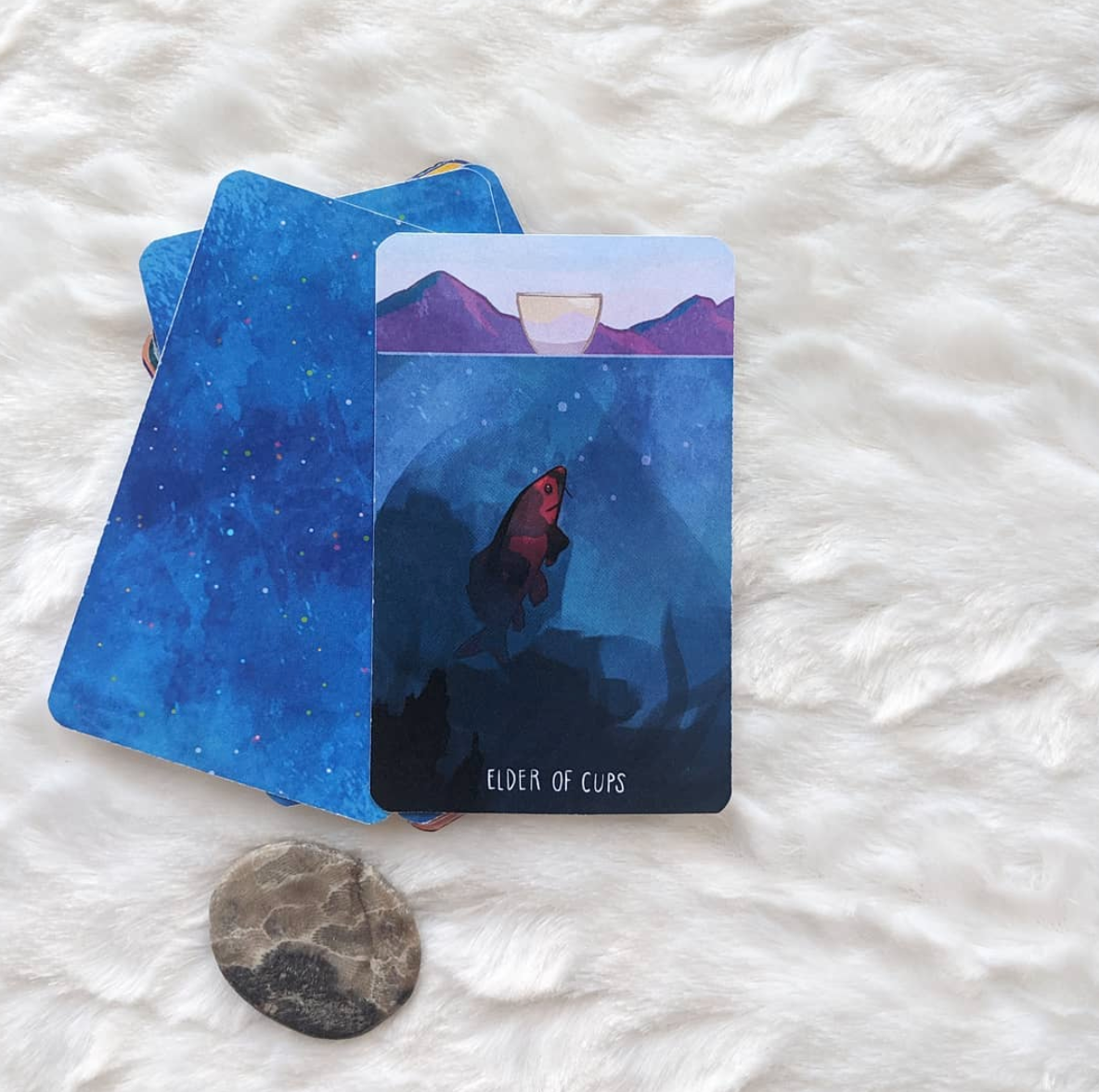
Diplomacy and the King of Cups
When I began learning tarot, one of the keywords I learned for the King of Cups is diplomatic. This has always stuck with me and is a key part of how I understand this card. Here’s the part where I do that clichè sharing the dictionary definition of a word thing, but I think it’s actually fruitful here so bear with me.
Diplomacy: skill in dealing with others without causing bad feelings. (Merriam-Webster)
Diplomacy: the art of dealing with people in a sensitive and effective way. (Oxford)
I see the court cards as representing specific aspects of personality. So when I draw a court card, I tend to begin by asking “in what ways am I currently aligned with this aspect of my personality? Is it helping or hurting? How can I better bring forward the useful aspects of this card within myself?”
So that’s how I got here, thinking about what it means to be diplomatic. What does diplomacy look like? Why is it important? In what ways have I been refusing to heed the wisdom of this card, hence causing it to show up for me again and again?
My first impulse is to get very defensive about how OTHER people aren’t being diplomatic. I mean, here in the US, we have a president who has normalized being (excuse my somewhat undiplomatic language) a hateful asshole who is constantly pouring gasoline on the fire of division. A lot of the discourse in the highest echelons of society is the opposite of diplomatic.
But tarot has this annoying way of being like “well, you can’t really control what other people do so maybe let’s think about how you can best process your own energy and then possibly you’ll show up in a way that inspires other people to transform as well.”
Ugh, tarot, you can be such a buzzkill. Making me examine myself instead of just constantly projecting shit onto other people. FINE THEN!
So, what can we learn here? How can I be a little more like the King of Cups even when existing amongst shadowy Emperors?
Well, the King is the adept one, and the suit of cups has to do with the emotional realm. So the King of Cups is someone who has a level of mastery in the emotional realm. They are not controlled by their emotions, but this doesn’t mean repression – it means contextualization. They are a leader who does not seek to divide and conquer, but rather to understand and unite.
Perhaps most important to the conversation here, the King of Cups understands the deep emotional undercurrents that move through every person and every situation. The fact is, we are all emotional driven creatures. Much more than we’d like to admit. A superpower of the King of Cups is that they know this. While some people seek to understand emotions in order to manipulate, this King seeks to understand emotions in order to maintain harmony.
In short, the King of Cups is diplomatic because being diplomatic works. That is, it works if you value peace and respect and compromise. If you really want to improve the well-being of yourself and others, if you really want to resolve conflicts, if you really want to be an effective leader…being diplomatic is the way.
Consider the alternative. The other ways are about shame, dehumanization, authoritarianism and control. If you read a history book or just take a look at the world around you, you’ll see these ways do not work in the long run. Probably we should all agree that these things are bad, but what do I know.
Here’s the kicker though: being diplomatic is soooooo hard. It’s much easier to just fly off the handle, blame other people for all the world’s problems, share hateful memes and lament about how people on the “other side” are at fault for everything. Aligning with your inner King of Cups requires you to challenge your base instincts and approach things from a deeper perspective. It ain’t easy, but it’s important.
Also important: this isn’t about putting on a ‘when they go low we go high’ air of superiority. It’s not about stroking your ego with the notion that you’re some ethically evolved being. It’s not about a naive expectation that we should all just get along (that’s more of a Page of Cups thing – the King has leveled up). It’s not about tone policing – this is a huge point: in some circumstances, being diplomatic is a privilege. This is DEFINITELY NOT about telling someone who is being abused or facing discrimination that they need to ‘just be nice.’ That is a distorted misinterpretation of this message and the King of Cups ain’t about it. The King of Cups is emotionally intelligent, not emotionally manipulative. Don’t get it twisted.
It is about realizing that the only sustainable path forward – both in our personal relationships and in broader cultural contexts – is diplomacy. I think it’s something worth expecting of ourselves (whenever it is reasonable) and also expecting from other people. We should not normalize or accept the erosion of diplomacy, because when we do, we’re in trouble.
I repeat: IT IS NOT EASY TO BE DIPLOMATIC. This requires great skill. It requires diving into your own depths, sifting through your shadowy unconscious, and bringing that wisdom to the surface (which is what you literally see in the image from the Spacious Tarot). It requires tremendous patience. It requires showing grace to yourself and others when you act out of impulse or shadow. It requires composure, compassion and inner stability.
To be honest, even trying to write diplomatically about diplomacy is a challenge for me. I’m more of a Knight of Cups than a King of Cups, most of the time, but you gotta evolve right? Or at least attempt to. I value diplomacy, and believe it is the way. And the Elder of Cups is nudging me, following me to say: so you believe this, do you? Then you must be willing to align with my energy and act accordingly. Again and again.
Begin or deepen your tarot studies with
Foundational Tarot, my free video course!
Join the email list for instant access.
Carrie Mallon
Header art from The Spacious Tarot illustrated by Annie Ruygt
All site content © Carrie Mallon LLC 2014-2019
Sign up for weekly updates


 I'm a tarot reader and mentor.
I'm a tarot reader and mentor. 